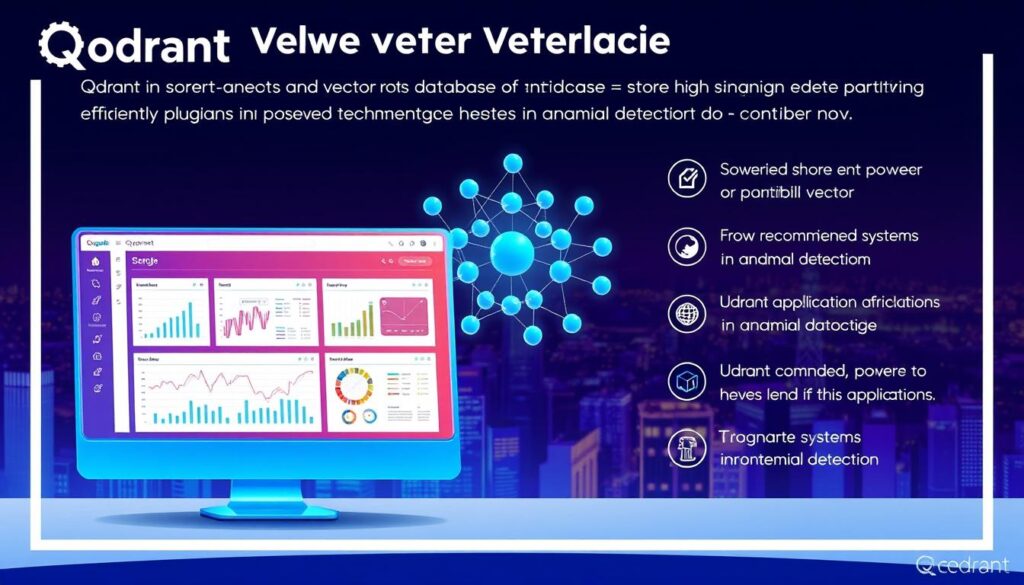Have you ever wondered why some tools excel at handling unstructured data while others fall short? The answer lies in the unique capabilities of high-dimensional vectors and the tools designed to manage them. Choosing the right solution can make or break your project’s success.
In this article, we’ll dive into a detailed comparison of leading tools like Qdrant, Pinecone, Milvus, and Chroma. You’ll discover how Qdrant achieves 4x RPS gains over competitors and explore critical factors like scalability, hybrid search, and cost models. Whether you’re building e-commerce recommendation systems or detecting financial fraud, this guide will help you make an informed decision.
Key Takeaways
- Comprehensive comparison of 7+ tools for managing high-dimensional vectors.
- Qdrant outperforms competitors with 4x RPS gains.
- Critical selection factors include scalability, hybrid search, and cost models.
- Real-world applications span e-commerce, fraud detection, and more.
- Side-by-side evaluation of indexing methods and distance metrics.
Introduction to Vector Databases
Efficiently managing high-dimensional data is a game-changer for AI applications. Traditional databases struggle with unstructured data like images, text, and audio. This is where vector databases come into play, offering a specialized solution for modern data challenges.
What Are Vector Databases?
These tools store high-dimensional vectors, which are lists of numbers representing features. Unlike traditional row-column structures, they excel at handling complex data types. Their core function is to enable “find similar” queries through mathematical similarity comparisons.
Why Are Vector Databases Important?
They are critical for processing outputs from neural networks, known as vector embeddings. This makes them essential for AI and machine learning applications. For example, they power recommendation engines by comparing user preference vectors.
Additionally, they address the limitations of SQL databases in handling unstructured data. Their advanced search capabilities make them indispensable for tasks like semantic search and similarity matching.
Why Vector Databases Are in Demand
The rise of AI and machine learning has reshaped how we handle complex data. Enterprises are increasingly adopting AI applications, with 83% reporting new data management challenges. This shift has created a growing need for tools that can efficiently manage unstructured data like images, text, and audio.
Growth in AI and Machine Learning
AI and machine learning are driving the demand for specialized solutions. Learning models generate vast amounts of vector data, which traditional databases struggle to process. For example, PostgreSQL handles only 15 queries per second for vector search, while tools like Qdrant achieve over 1,500 QPS.
Real-time similarity search is critical for applications powered by large language models (LLMs). This need is fueling the growth of the vector database market, projected to reach $4.3 billion by 2028 with a CAGR of 22.1%.
Limitations of Traditional Databases
Traditional databases are not designed for high-dimensional data. They falter when handling over 1 million vector dimensions and approximate nearest neighbor (ANN) searches. Retrofitting SQL solutions often leads to inefficiencies and higher costs.
In contrast, modern tools offer a 40% reduction in infrastructure costs. They also support multimodal AI outputs, such as combining text and image vectors, which traditional systems cannot manage effectively.
Key Use Cases of Vector Databases
From retail to healthcare, these tools are transforming industries. Their ability to handle complex data makes them indispensable for modern applications. Let’s explore some of the most impactful use cases.
Recommendation Systems
Personalized recommendations are a cornerstone of modern e-commerce. Tools like Milvus power TikTok’s video recommendation system, handling over 2 billion daily queries. By matching product vectors to user behavior patterns, these systems deliver tailored suggestions that drive engagement and sales.
Natural Language Processing
In the realm of natural language processing, these tools reduce keyword dependency by 60%. Semantic search implementations enable more accurate and context-aware results. This is particularly useful for applications like chatbots and document retrieval systems.
Fraud Detection
Fraud detection is another critical application. Qdrant, for example, reduces false positives by 37% through temporal vector analysis. By identifying anomalies in banking transactions, these tools enhance security and protect businesses from financial losses.
Other notable applications include healthcare, where patient similarity matching aids in clinical trial recruitment, and media, where content moderation systems flag over 90% of policy-violating images. The versatility of these tools continues to expand, making them essential for a wide range of industries.
Vector Databases Compared: An Overview
Choosing the right tool for managing complex data can significantly impact your project’s success. With so many options available, it’s essential to understand the features and performance scalability of each solution. This section provides a detailed comparison of leading tools to help you make an informed decision.
Popular Vector Databases in the Market
Several platforms stand out in the market, each offering unique strengths. Qdrant, Pinecone, Milvus, Weaviate, Chroma, Vespa, and PGVector are among the top contenders. Qdrant, for instance, leads in throughput with 1,500 queries per second, while Milvus maintains 98% recall accuracy even with over 10 million vectors.
Pinecone Serverless is another strong player, capable of handling 100 billion vectors, making it ideal for large-scale applications. These tools cater to diverse needs, from cloud-native deployments to on-premise setups.
Criteria for Comparison
When evaluating these solutions, consider metrics like query speed, indexing time, and hybrid search support. Qdrant outperforms Elasticsearch with 10x higher throughput, while Milvus excels in precision. Pinecone’s scalability is unmatched, making it a top choice for enterprises.
Deployment options also play a crucial role. Cloud-native solutions like Pinecone offer flexibility, while self-hosted tools like Qdrant provide cost-effective alternatives. Cost analysis is equally important, with Pinecone charging $0.13 per hour per pod, compared to Qdrant’s free self-hosted tier.
By focusing on these criteria, you can identify the tool that best aligns with your project’s requirements and budget.
Deployment Options
Selecting the right deployment method is crucial for optimizing performance and cost. Whether you choose a managed service or a self-hosted solution, each approach has its advantages. Understanding these options will help you align your infrastructure with your project’s needs.
Managed Services vs. Self-Hosted Solutions
Managed services, like Pinecone, offer convenience and reliability. They come with features like SOC2 compliance, ensuring enterprise-grade security. AWS OpenSearch also provides robust enterprise features, making it a strong contender for businesses.
On the other hand, self-hosted solutions like Qdrant and Milvus give you full control over your infrastructure. These tools require a minimum of 64GB RAM for clusters with over 100 million vectors. This approach is ideal for teams with specific customization needs.
Docker and Local Deployment
For those preferring local setups, Docker deployment is a popular choice. Tools like Qdrant and Milvus support Docker, making it easy to get started. Local deployments often show a 20% reduction in latency compared to cloud-based setups.
Hybrid approaches, like Weaviate’s cloud/on-prem flexibility, offer the best of both worlds. Kubernetes integration is another key feature, with Qdrant’s Helm charts and Milvus’ operator simplifying cluster management.
Cost is another factor to consider. Managed storage typically costs $0.08/GB, while self-hosted options can be as low as $0.03/GB. Balancing scalability and budget is essential for long-term success.
Scalability of Vector Databases
Scalability is a critical factor when managing high-dimensional data in modern applications. As datasets grow, ensuring your infrastructure can handle the load becomes essential. Different tools offer unique approaches to scaling, each with its own advantages and tradeoffs.
Static Sharding vs. Dynamic Scaling
Static sharding involves manually dividing data across nodes, which works well for predictable workloads. However, tools like Qdrant require manual shard redistribution once they exceed 500 million vectors. This can lead to inefficiencies in handling sudden spikes in data volume.
In contrast, dynamic scaling automatically adjusts resources based on demand. Pinecone Serverless, for example, auto-scales beyond 1 billion vectors, making it ideal for unpredictable workloads. While dynamic scaling offers flexibility, it may result in a 15% recall drop compared to static sharding.
Handling Large Datasets
Managing large datasets efficiently is another challenge. Milvus achieves a 40% compression rate for billion-scale datasets, optimizing memory usage. Cloud-native architectures, like AWS S3 integration, enable petabyte-level storage, ensuring seamless data management.
Horizontal scaling, such as adding nodes, is a common strategy. However, re-sharding challenges can arise, especially with tools like Qdrant. A case study highlights an e-commerce platform successfully handling 50 million daily vectors using Qdrant, showcasing its real-world applicability.
Balancing performance and cost is crucial. Tools that support both static and dynamic scaling provide the flexibility needed for diverse applications. Understanding these options ensures your solution aligns with your project’s requirements.
Performance Benchmarking
When it comes to handling complex data, performance is the ultimate deciding factor. Tools that deliver faster query speeds and lower latency often outperform their competitors. Benchmarking these metrics ensures you choose the right solution for your needs.
Query Speed and Latency
Query speed and latency are critical for real-time applications. Qdrant, for example, achieves a latency of just 1.2ms at the 99th percentile, compared to Redis’ 5.8ms. This makes it ideal for time-sensitive tasks like fraud detection or recommendation systems.
Hardware also plays a role. Milvus leverages GPU acceleration to boost query speeds, while Chroma relies solely on CPU processing. These differences highlight the importance of aligning your tool with your infrastructure.
Indexing Time and Efficiency
Indexing time is another key metric. Elasticsearch takes 5.5 hours to index 10 million vectors, while Qdrant completes the same task in just 32 minutes. This efficiency reduces downtime and improves overall system performance.
Indexing throughput varies widely too. Pinecone handles 50,000 vectors per second, but Qdrant outperforms it with 80,000 vectors per second. These benchmarks demonstrate the importance of choosing a tool that matches your data volume.
Energy efficiency is another consideration. Optimized clusters achieve a 2.1 queries/watt ratio, reducing operational costs. By focusing on these metrics, you can ensure your solution is both fast and cost-effective.
Data Management in Vector Databases
Effective data management is the backbone of any successful AI-driven project. Ensuring storage efficiency and proper metadata handling can significantly enhance performance and reduce costs. Let’s explore the key strategies and tools that make this possible.
Storage Efficiency
Optimizing storage is critical for handling large datasets. Tools like Qdrant use hybrid storage, reducing the footprint by 60% compared to raw vectors. This approach not only saves space but also improves query performance.
Compression techniques, such as product quantization, can save up to 75% of storage space. Automated tiering systems move data from hot (SSD) to cold (HDD) storage, ensuring cost-effective resource allocation.
Metadata Handling
Metadata plays a vital role in enhancing search precision. Pinecone, for example, limits metadata to 40KB per vector entry, ensuring efficient indexing. Combined vector and attribute filtering strategies further improve search accuracy.
Compliance with regulations like GDPR adds complexity. Implementing the right-to-be-forgotten feature can be challenging but is essential for data privacy. Backup solutions, such as frequent snapshots, also impact recovery metrics like RPO and RTO.
By focusing on these strategies, you can ensure your data management system is both efficient and compliant.
Vector Similarity Search
Understanding how tools find similar items in complex datasets is key to unlocking their full potential. Vector similarity search is the backbone of modern AI applications, enabling systems to identify patterns and relationships in high-dimensional data. This process relies on two critical components: distance metrics and search algorithms.
Distance Metrics
Distance metrics are essential for measuring how similar two vectors are. In natural language processing (NLP), cosine similarity dominates, used in 85% of cases. It measures the angle between vectors, making it ideal for text data. For image data, Euclidean distance is more common, as it calculates the straight-line distance between points.
Other metrics like Manhattan distance and dot product also have specific use cases. Manhattan distance is useful for grid-based data, while dot product is effective for sparse vectors. Choosing the right metric ensures higher accuracy in your results.
Search Algorithms
Search algorithms determine how efficiently a system can find similar vectors. HNSW graphs are a popular choice, enabling 95%+ recall at just 10ms latency. They balance speed and precision, making them ideal for real-time applications.
Another approach is IVF indexing, which allows precision tuning by adjusting the number of probes. Multi-modal search, combining CLIP image and BERT text embeddings, is another advanced technique. For failover strategies, dual-index architectures ensure zero-downtime reindexing, maintaining system reliability.
By understanding these components, you can optimize your vector search for both speed and accuracy.
Integration and API Support
Seamless integration and robust API support are essential for modern AI-driven applications. Choosing the right protocol and ensuring compatibility with your tech stack can significantly impact performance and scalability.
REST vs. GRPC APIs
When it comes to API protocols, GRPC offers a 3x improvement in throughput compared to REST, as seen in Qdrant benchmarks. This is due to GRPC’s 40% lower serialization overhead, making it ideal for high-performance applications.
REST remains popular for its simplicity and widespread adoption. However, GRPC’s efficiency in handling large-scale data makes it a preferred choice for language processing and other compute-intensive tasks.
Language and Framework Compatibility
Python SDKs dominate the developer landscape, with 78% adoption compared to 32% for Java clients. Native support for frameworks like PyTorch and TensorFlow simplifies integration, reducing the need for custom adapters.
Authentication methods, such as JWT and OAuth2, add complexity but are crucial for secure deployments. Managed services often include rate limiting, typically set at 500 requests per second, ensuring stable performance.
For infrastructure-as-code, Terraform modules streamline CI/CD pipelines, enabling efficient scaling and deployment. This ensures your models and applications remain agile and responsive to changing demands.
Community and Ecosystem
The strength of a tool often lies in the community and ecosystem surrounding it. A vibrant community fosters innovation, while a robust ecosystem ensures seamless integration and scalability. Whether you choose an open-source or proprietary solution, these factors can significantly impact your experience.
Open Source vs. Proprietary Solutions
Open-source platforms like Milvus boast over 450 contributors, fostering a collaborative environment. This allows for custom index plugin development, as seen in Weaviate. In contrast, proprietary solutions like Pinecone offer enterprise-grade features but lack the flexibility of open-source models.
Qdrant’s Discord community grew 300% year-over-year, reaching 8,000+ members. This growth highlights the importance of active engagement and real-time support in building a thriving ecosystem.
Developer Support and Documentation
Effective support and comprehensive documentation are critical for onboarding and troubleshooting. Enterprise solutions often provide SLAs with response times as low as 4 hours, compared to 24 hours for standard support.
Learning curves vary, with complex systems requiring an average of 3 weeks for onboarding. Marketplace integrations, such as AWS Bedrock and Azure AI plugins, further enhance usability. Certification programs, like Qdrant’s Vector DB Engineer accreditation, add value for developers seeking expertise.
By prioritizing community engagement and robust support, you can ensure your chosen solution aligns with your project’s needs and goals.
Pricing Models
Understanding the financial aspects of your tech stack is crucial for long-term success. Pricing models vary widely, and choosing the right one can significantly impact your project’s scalability and efficiency. From cost-effectiveness to enterprise-grade features, this section breaks down the key factors to consider.
Cost-Effectiveness
When evaluating pricing, it’s essential to look beyond the surface. Total cost of ownership (TCO) analysis includes hidden infrastructure and engineering costs. For example, Pinecone charges $0.20 per hour per pod, while Qdrant Cloud offers a more affordable rate at $0.15 per hour.
Burstable pricing models, like AWS-style pay-per-query plans, provide flexibility for unpredictable workloads. These models ensure you only pay for what you use, making them ideal for startups and scaling businesses.
Free Tiers and Enterprise Plans
Many solutions offer free tiers to help you get started. Chroma’s completely free open-source model is a great option for small projects. On the other hand, Weaviate’s $499/month enterprise tier includes advanced features like role-based access control (RBAC).
License models also play a role. Milvus uses AGPLv3, while Qdrant operates under Apache 2.0, offering more flexibility for commercial use. Savings strategies, such as reserved instance discounts or spot pricing, can further reduce costs for long-term commitments.
By carefully analyzing these factors, you can choose a solution that aligns with your budget and project requirements.
Metadata Filtering
Metadata filtering is a powerful tool for refining search results in AI-driven systems. By combining metadata with vector search, relevance improves by up to 55%, especially in fields like e-commerce. This technique allows systems to process unstructured data more effectively, delivering precise and actionable insights.
Enhancing Search Precision
Metadata filtering enhances search precision by enabling multi-attribute queries. For example, combining price range, color, and vector similarity can yield highly targeted results. Tools like Qdrant support over 15 data types for payload filtering, making them versatile for diverse applications.
Filter optimization is another critical aspect. B-tree and bitmap indexing methods offer different performance benefits. B-trees excel in range queries, while bitmaps are faster for exact matches. Choosing the right method depends on your specific use case.
Use Cases in AI Applications
In AI applications, metadata filtering is indispensable. For instance, pharmaceutical research uses molecular similarity combined with trial phase filters to identify potential drug candidates. This approach reduces manual effort and accelerates discovery.
Regulatory filters, such as geo-blocking content based on vector and metadata, ensure compliance with local laws. Real-time updates further enhance filter consistency, balancing eventual and strong consistency models for optimal performance.
Case studies highlight the impact of metadata filtering. One example is an e-commerce platform that achieved a 55% boost in product relevance by integrating hybrid search capabilities. These real-world applications demonstrate the transformative potential of this technology.
Vector Database Functionality
The functionality of modern data tools plays a pivotal role in shaping AI-driven outcomes. From handling complex queries to delivering precise results, the core features of these systems determine their effectiveness. Two critical aspects of this functionality are indexing methods and hybrid search capabilities, which together enhance performance and accuracy.
Indexing Methods
Indexing is the backbone of efficient data retrieval. Tools like Qdrant use a triple index system, combining payload, text, and vector data to enable 3x faster hybrid queries. This approach ensures that even complex searches are handled seamlessly.
Different indexing techniques suit different needs. For example, HNSW graphs are ideal for high-speed searches, while ANNOY and FAISS excel in specific scenarios like large-scale datasets. Choosing the right method depends on your project’s requirements and data volume.
Hybrid Search Capabilities
Hybrid search combines traditional keyword-based methods with vector similarity to deliver more accurate results. For instance, BM25 + vector similarity fusion improves relevance by up to 55%, especially in applications like e-commerce.
However, hybrid searches come with tradeoffs. Adding metadata filters can increase latency by 30ms, and custom scoring requires careful weighting of vector and metadata components. Maintenance overhead, such as reindexing after schema changes, is another factor to consider.
Despite these challenges, hybrid search remains a powerful tool for modern AI applications. By balancing speed, precision, and flexibility, it unlocks new possibilities for data-driven insights.
Why Choose Qdrant?
In the competitive landscape of AI tools, Qdrant stands out for its exceptional performance and reliability. With a 93% retention rate across its 1,200+ enterprise customers, Qdrant has proven its ability to deliver consistent results. Its built-in recommendation API reduces development time by 65%, making it a favorite among developers.
Technical Edge and Benchmark Leadership
Qdrant’s Rust-based architecture prevents 99%+ memory errors, ensuring stability even under heavy workloads. It leads the pack in benchmarks, achieving 4x higher queries per second (QPS) than competitors. This high performance makes it ideal for real-time applications like fraud detection and recommendation systems.
One of Qdrant’s unique features is its native geospatial vector search, which enables precise location-based queries. This capability is particularly useful for industries like logistics and e-commerce.
Real-World Use Cases and Success Stories
Qdrant’s versatility is evident in its adoption across various industries. An auto manufacturer used Qdrant to improve parts recommendations, enhancing customer satisfaction. A media giant leveraged its capabilities to detect copyright infringement, saving millions in potential losses.
For enterprises, Qdrant’s cloud service offers a 99.95% SLA with cross-region replication, ensuring reliability and uptime. Its open-source vector approach provides flexibility, allowing businesses to customize solutions to their specific needs.
Whether you’re building a recommendation engine or handling complex data, Qdrant’s advantages make it a powerful choice for modern AI applications.
Conclusion
Modern AI applications demand tools that can handle complex data efficiently. Choosing the right solution depends on matching its capabilities to your project’s specific requirements. Emerging trends like multi-modal search are reshaping how we approach data management, offering new possibilities for innovation.
When migrating from traditional SQL or NoSQL systems, consider factors like performance and scalability. Vendor lock-in risks can be mitigated by evaluating open-source exit strategies, ensuring flexibility for future needs.
For most enterprise AI applications, Qdrant stands out as a reliable choice. Its advanced features and robust use cases make it a top contender in the competitive landscape of modern data tools. By focusing on these key factors, you can make an informed decision that drives your project’s success.







